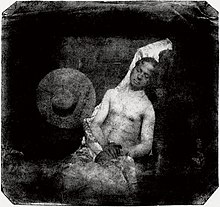Combination printing
| Example of Early Combination Print Photos | |
|---|---|

Hippolyte Bayard's Self Portrait as a Drowned Man, 1840
|
|
| Website | http://www.getty.edu/art/gettyguide/artMakerDetails?maker=1876 |
Combination printing is the photography technique of using the negatives of two or more photographic images in conjunction with one another to create a single image.
Similar to dual-negative landscape photography, combination printing was technically much more complex. The concept of combination printing stemmed from the desire to create more of a fine art within photography and often more idealized images.
Combination printing was popular in the mid-19th century due to the limitations of the negative's light sensitivity and camera technology. For example, the long exposures required at the time to create an image would properly expose the main subject, such as a building, but would completely overexpose the sky. The sky would then lack detail, usually appearing as solid white. Hippolyte Bayard, a French photographer, was the first to suggest combining two separate negatives, one of the subject matter and one of a properly exposed negative of clouds, to create a balanced photograph.
The technique was also used to create new, original compositions and provided new ways for photographers to be more creative with their work.
Later on, the technique paved the way for yet another artistic process, photomontage.
In combination printing, you use two or more negatives to make one good print.
Combination printing required a lot of careful work to plan out the concept of what the final image was desired to look like. It was also a task of great skill and patience. When a photographer wished to create a combination print, issues of good exposures, scaling the subjects to match up, and consistent lighting were all essentials if they aimed to make it look as realistic as possible.
For instance, in the example of combining a foreground subject with adding clouds to a sky, it is important to make sure that the direction of the light falling on the clouds is the same as the light used on the main subject in the original foreground negative.
In actually exposing the negatives to combine them, the photographer must control the exposure of the portion of the initial photo that they will be adding to or replacing. Therefore, for adding clouds into the sky, the photographer would have to hold back light from the sky area and expose the foreground area. Then, when printing the negative of the clouds, do the opposite and only expose the cloud and sky portion of the photo. After this, they would be able to combine the two negatives by blending them together.
...
Wikipedia
